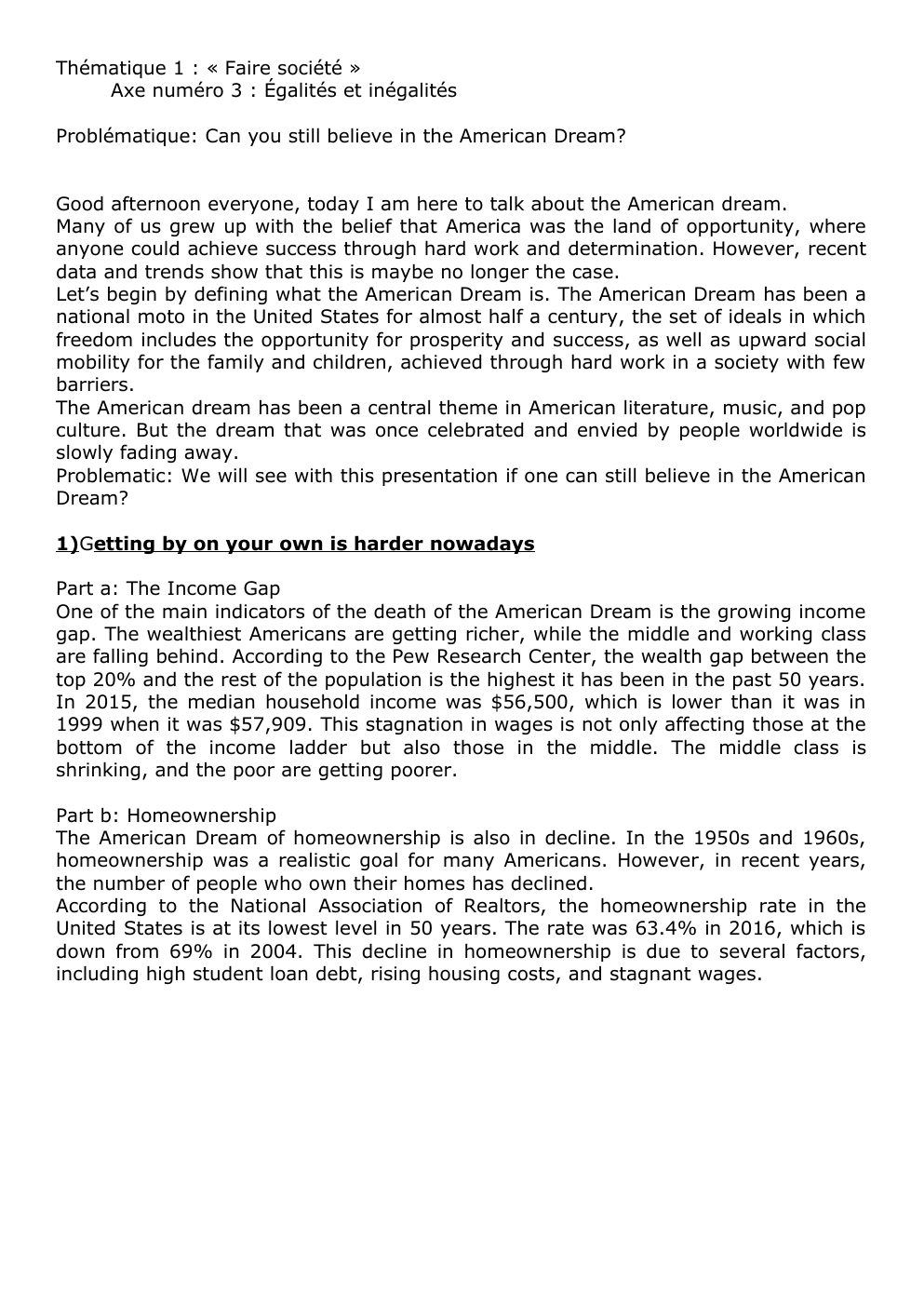AMC bac oral: Thématique 1 : « Faire société » Axe numéro 3 : Égalités et inégalités Problématique: Can you still believe in the American Dream?
Publié le 29/05/2023
Extrait du document
«
Thématique 1 : « Faire société »
Axe numéro 3 : Égalités et inégalités
Problématique: Can you still believe in the American Dream?
Good afternoon everyone, today I am here to talk about the American dream.
Many of us grew up with the belief that America was the land of opportunity, where
anyone could achieve success through hard work and determination.
However, recent
data and trends show that this is maybe no longer the case.
Let’s begin by defining what the American Dream is.
The American Dream has been a
national moto in the United States for almost half a century, the set of ideals in which
freedom includes the opportunity for prosperity and success, as well as upward social
mobility for the family and children, achieved through hard work in a society with few
barriers.
The American dream has been a central theme in American literature, music, and pop
culture.
But the dream that was once celebrated and envied by people worldwide is
slowly fading away.
Problematic: We will see with this presentation if one can still believe in the American
Dream?
1)Getting by on your own is harder nowadays
Part a: The Income Gap
One of the main indicators of the death of the American Dream is the growing income
gap.
The wealthiest Americans are getting richer, while the middle and working class
are falling behind.
According to the Pew Research Center, the wealth gap between the
top 20% and the rest of the population is the highest it has been in the past 50 years.
In 2015, the median household income was $56,500, which is lower than it was in
1999 when it was $57,909.
This stagnation in wages is not only affecting those at the
bottom of the income ladder but also those in the middle.
The middle class is
shrinking, and the poor are getting poorer.
Part b: Homeownership
The American Dream of homeownership is also in decline.
In the 1950s and 1960s,
homeownership was a realistic goal for many Americans.
However, in recent years,
the number of people who own their homes has declined.
According to the National Association of Realtors, the homeownership rate in the
United States is at its lowest level in 50 years.
The rate was 63.4% in 2016, which is
down from 69% in 2004.
This decline in homeownership is due to several factors,
including high student loan debt, rising housing costs, and stagnant wages.
II Richer are getting richer, and the poor are getting poorer
Part a: The Cost of Education
Another significant issue that is contributing to the death of the American Dream is
the cost of education.
The cost of college education has skyrocketed, and it is now
harder than ever for people to obtain a higher education without incurring huge
amounts of debt.
In 2017, the average student loan debt was $37,172, and this is just for a bachelor's
degree.
The cost of education has gone up by over 200% in the past 30 years, while
the median household income has only increased by 29% over the same period.
Part b: Social climbing
Finally, social climbing, which is a central principle of the American Dream, has been
declining.
Social mobility is the ability of individuals or families to move up or down
the economic ladder.
Unfortunately, the United States has one of the lowest levels of
social climbing among industrialized nations.
According to a study by the Pew Charitable Trusts, social mobility has not improved in
the United States in the past several decades.
A child born into a low-income family in
the United States is less likely to move up the income ladder than a child born into a
low-income family in other developed countries.
In a Nutshell, the American Dream is over.
The income gap, the cost of education, the
decline in homeownership, and the lack of social mobility have all contributed to the
end of the American Dream.
It is up to us to find new ways to make....
»
↓↓↓ APERÇU DU DOCUMENT ↓↓↓
Liens utiles
- Grand Oral PHYSIQUE-CHIMIE Problématique : Dans quelle mesure la chimie a-t-elle contribué à la résolution de l’affaire du meurtre d’O.J Simpson (malgré les obstacles juridiques et médiatiques durant le procès) ?
- Entraînement bac SES: Dans quelle mesure les pays de la zone euro peuvent-ils faire face à un choc asymétrique ?
- Asie du Sud Est: les coopérations internationales arriveront-elles à faire disparaitre les inégalités d'intégrations entre les territoires?
- fiche révision oral bac francais remords posthume
- S'il y a des inégalités naturelles, la société doit-elle les admettre ou les compenser ?





